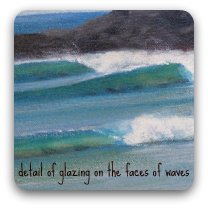Acrylic Glazing.
A Match Made In Heaven.
Discover how acrylic glazing techniques can make your paintings glow with light and life.
I love glazing with acrylics. The two things are perfect for one another. Not only can this technique improve the light and life in your paintings, it can also be a sensational way of saving your art from disaster.
Basically, glazing is a very thin mix of colour. This is achieved by diluting your paint, and applying it thinly. I use Artists quality acrylic paints by Chroma Australia, Atelier Interactive and Atelier Free Flow.
The beauty of it is that you can alter hues in very subtle ways. You can increase the drama of a gradation of colour, and best of all, you can create a lovely brightness that's difficult to achieve without glazing.
A glaze can be as complicated or as simple as you like. There are lots of additives that you can use to create a glaze. You can, in fact, just use water.
BUT. Remember that acrylic paint is basically glue full of coloured grit. The more water you add, the more you break down the glue. This can cause a problem if you have diluted your paints too much. Working over the top of a too-dilute acrylic glaze can sometimes remove it entirely, or in parts. It's difficult to control.
I recommend using a glazing medium of some description. Alternatively, you could add some clear painting or gloss medium to boost the "glues". This has the added benefit of suspending the "grains" of pigment above the surface beneath. Almost like it's floating.
This allows the light to travel through the glazing medium, to the surface; and bounce back through the pigment. It creates a wonderful brightness and lustre that is lost a little when only thinning with water.
TIP: next time you paint a sunset and you mix your pigment with white, you may notice the image doesn't seem to have the brightness that you want. This is where an acrylic glaze works perfectly. A thin wash of bright colour and BLAMMO! There's that life and brightness you were trying to achieve.
The wonderful thing about using this process with acrylics, and acrylic mediums, is that you can re-apply another glaze (depending on the weather) in about 20 minutes. No more waiting for weeks. First glaze not quite right? No worries. Add another in 20.
Being a good painter means you have some skills. But it also means having a range of techniques to recover from any "mistakes". Acrylic glazing is a must. If you've ever painted a sky for example, and it looks a little "flat", sometimes a glaze across the upper part of the sky can deepen the contrast enough. Being able to strengthen or reduce a gradation of colour is a wonderful "get out of jail free" card.
TIME TO EXPERIMENT PEOPLE!!
Block in a flat, pale colour on a small canvas. Grab some glazing medium (I know, I know, I like the Atelier stuff - I am having a bit of a love affair with the new glazing liquid at the moment), dilute it with a little water, pick up a touch of colour and mix it with the medium.
Now brush it over the top of your canvas and see how it alters the colour beneath. You'll be amazed at how luminous the canvas becomes with the addition of a tiny bit of pigment.
Of course you can add as much or as little as you want. Experiment with similar canvases and see how cool colours can be altered to warmer with a thin glaze.
As another experiment, you could try painting in a similar way to watercolourists. In other words, add glazes to build up dark areas, and leaving the white to shine through in the highlights. This can give your shadows so much depth.
Some glazing mediums allow you to paint directly onto your painting. You then add your pigment to the wet medium and blend directly on your painting. You can even push the pigment away from areas, and into others. Beautiful.
Adding more and more glazes over the top of one another, particularly when using a lot of medium, gives the surface a luscious and substantial feel. It looks great.
If you have felt a little overwhelmed by glazing techniques in the past, put that feeling to bed.
It's time to experiment and watch your paintings truly come to life!
Check out our Youtube channel Explore Acrylics for some practical glazing exercises, including this one:
Back To Acrylic Painting Techniques
Back to Explore Acrylic Painting Home Page



















New! Comments
Have your say about what you just read! Leave me a comment in the box below.